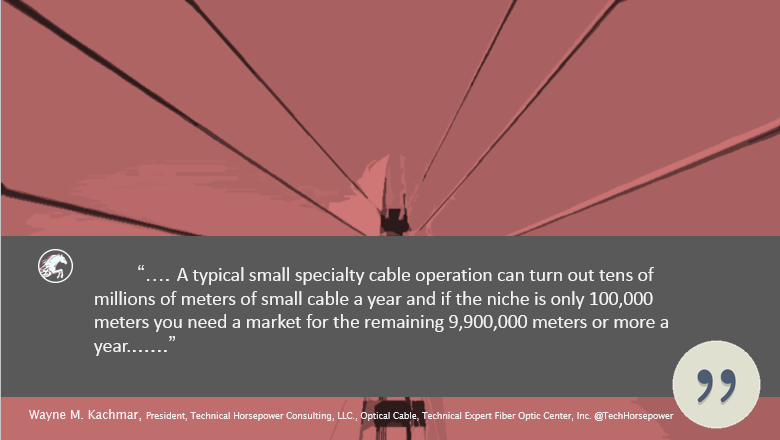At the 65th IWCS International Cable & Connectivity Symposium, Technical Horsepower Consulting, LLC. (THC) presented a short talk on Starting a Cable Company and/or Adding a Cable Making Division.
The talk included a handout outlining the basic questions that anyone contemplating starting a cable operation needs to answer just to define the boundaries of a business plan.
Everyone who ever sees the amount of optical cable being deployed seems to think there is a shortage of cable. In reality, there are seasonal and market fluctuations that cause shortages. While there are many who want to look at starting a cable operation, there are a few basic questions that need to be answered before you even start to talk to the cable-making equipment manufacturers.
After being contacted by several people interested in this topic but unable to attend the live event, I have put this article together.
Several prospective clients have contacted me with a similar request. Although there are some additional reasons for wanting to start a cable company the usual spark of an idea is an article about the volumes of optical cable being deployed or a temporary shortage of fiber or cable. It generally goes something like this:
“I want to start an optical cable company and need help deciding whose equipment to purchase, what will it cost to build a cable factory?”
This type of inquiry prompts me to start asking questions about the types of cables produced, who the customers are and who are the material/fiber suppliers. The usual answer to those questions are fiber optic cable, everybody who needs cable and tell me who to use and I will buy from them.

Cable types
First, there are many different cable types. Each of these are manufactured differently and require different manufacturing equipment and methods. In a broad sense there are three major segments:
- High fiber long haul black cable that hangs on poles or is direct buried
- Flame retardant cable that contains one to 144 fibers and is safety listed (UL OFN, OFNR or OFNP in the USA and Low Smoke Zero Halogen in other parts of the world)
- Specialty cable that includes many other types of cables used in military, scientific and sensor applications.
Each of these has many additional variations such as self-support drop cable for long haul cable and umbilical cables for specialty etc. The Volumes of optical fiber for each are very different as well as fiber types. In general most folks have a vague idea of how they will go to market but have not done the detailed homework.
Why will you be able to make and sell cable better and cheaper than the existing suppliers?
In several cases, the potential client had a possible niche opportunity but did not recognize the scale required. A typical small specialty cable operation can turn out tens of millions of meters of small cable a year and if the niche is only 100,000 meters you need a market for the remaining 9,900,000 meters or more a year. And long haul black cable is a volume only product as small producers may not be able to be competitive without volume pricing on fiber and materials.
Supply of critical materials including fiber
In general there is rarely a shortage of optical cable that cannot be traced back to an optical fiber shortage. And before you go thinking that a fiber manufacturing facility is the answer, remember that here again volume is king and much of the shortages are time sensitive and temporary. Several start-ups over the years in fiber drawing and or perform manufacturing did not get into operation before the shortage was eased and found themselves with no buyers.
Short form set of questions to ask yourself if you think you want to start a cable operation
As you can see, equipment vendors are pretty far down the list of to dos. Generally when a potential client answers these questions, they can determine not only if but what kind of operation would make sense in their opportunity.
- Review the products you want to produce.
- Determine who is buying them now and the volume they buy.
- Find out who the competition is and their respective relationships with the expected customers.
- Understand the specifications and qualifications that will be required to sell in those chosen markets (i.e. IEC standards, flammability and safety standards, etc.).
- Understand supplier relationships and costs of your enterprise and competitors (some may be integrated fiber and cable producers)
- Develop a SWOT model and refine focus.
- Create a Performa cost and selling price model to determine minimum sustained volume to compete on costs.
- Generate an equipment list, talent acquisition plan and develop a business plan. (Now is the time to discuss equipment with potential suppliers.)
- Test business plan assumptions with potential customers and suppliers.
- Refine business plan.
As always if you want to discuss further please contact me and we can explore the options. Both Starting a Cable Company and Adding a Cable Making Division are areas that THC provides in-depth consulting for.



